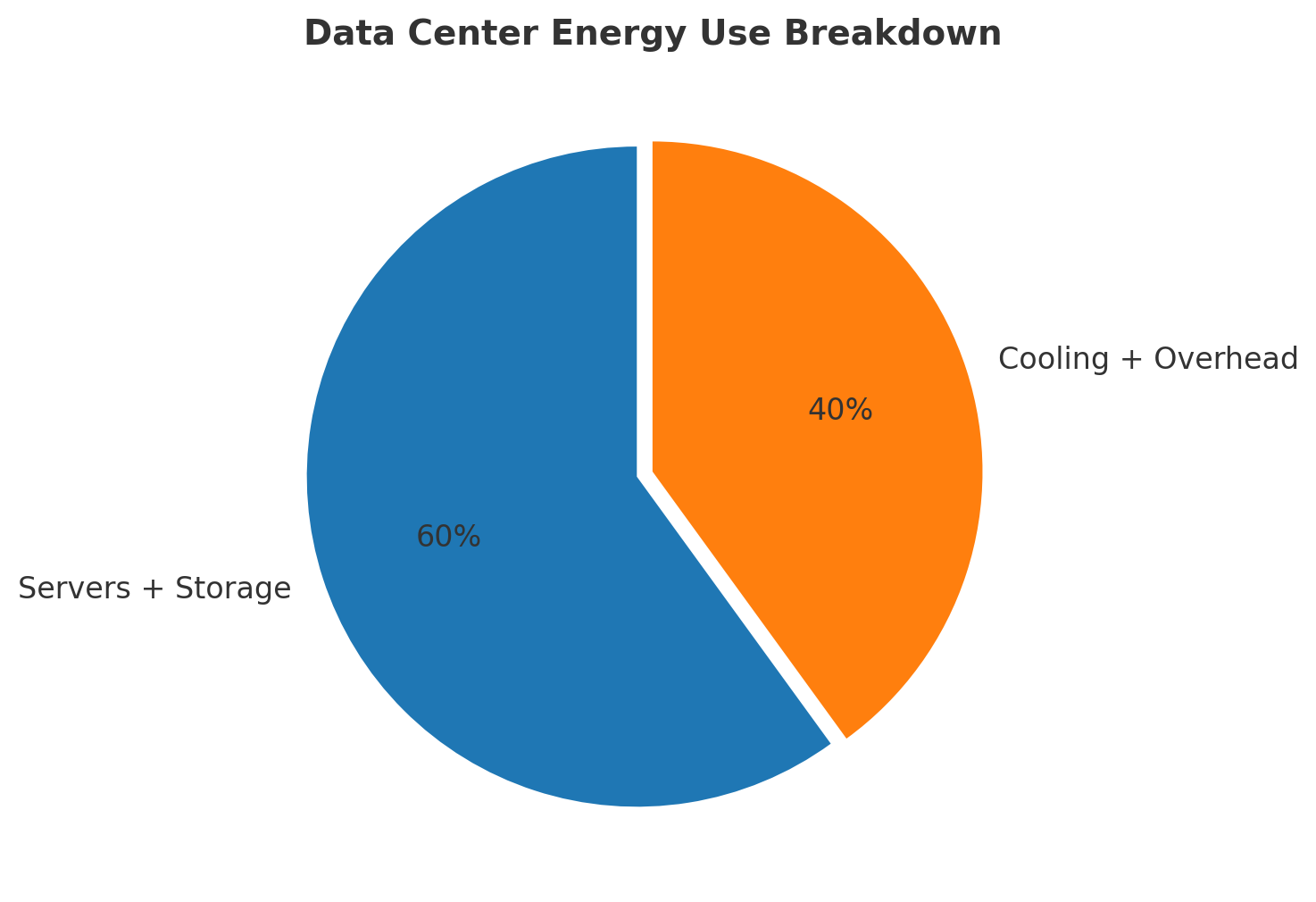When Water Meets Wires: Demystifying Data Centers, Water, and Justice
The Cloud Has a Body
We speak of “the cloud” like it’s floating above us. But the cloud has a body. It lives in data centers, sprawling buildings filled with racks of servers that run hot and need constant cooling.
That cooling isn’t free. It takes power. And it takes water. A mid-size data center, according to the Wall Street Journal, uses about 130 million gallons of water per year. That’s the same as three hospitals, 100 acres of almond orchards, or two 18-hole golf courses.
The chart says it all:
Data Center (15 megawatt) → 130M gallons
Hospital (3 buildings) → 130M gallons
Almond Orchard (100 acres) → 115M gallons
Golf Courses (2 full courses) → 100M gallons
Numbers like that should make us pause. Because every gallon cooling servers is a gallon not cooling communities.
How Data Centers Drink
Look at the diagram from Submer: water flows from power plants, through treatment systems, into the data center itself, and out again into wastewater. Every step in that cycle draws on local supply. Cooling towers evaporate water into thin air. Treatment plants add chemicals to keep pipes clean. Servers run hotter as AI workloads grow, which means more fans, more chillers, and more gallons. The hidden truth is this: the cloud’s thirst is tied to your neighborhood’s faucet.
Growth without pruning leads to destruction. Some things must be cut off for life to thrive.
Here’s what must end in data center expansion:
Silent siting- building in water-stressed regions without public voice.
Unlimited thirst- treating water like an infinite resource.
Secrecy- hiding true usage numbers behind corporate contracts.
We’ve seen this before. Highways cut through Black neighborhoods. Factories polluted our air. Now the same cycle is showing up in the digital economy. If leaders don’t name and end harmful practices, the next generation will inherit the same scars, only hidden behind server racks.
Power, Water, and the Double Pull
Cooling doesn’t just drink water; it burns electricity.
Studies show cooling systems can consume up to 40% of a data center’s total energy load.
Every AI query, every streamed video, doesn’t just cost watts; it costs water. And the faster AI grows, the thirstier the system becomes.
Sometimes statistics only land when you put them beside something familiar.
A single hamburger requires ~450–660 gallons of water to produce (UNEP, WEF, WaterCalculator). That’s feed crops, animal hydration, processing, and packaging.
By comparison, 100 people using ChatGPT in a day consumes far less than a burger.
But scale it up, billions of queries daily, and the cost adds up. The point isn’t to shame hamburgers or chatbots. It’s to show that water has value, and the way we assign it, to food, to tech, to leisure, reveals our priorities.
Redesigning the Game
My focus is merging Gamification with the Church. Gamification isn’t about gimmicks. It’s about rules. Who sets them? Who benefits? Who loses? Tech companies are already playing their game. Their scoreboard is profit. Their timeline is speed. Their strategy is scale. Communities don’t even have a jersey.
Black leaders can’t afford to sit in the stands. We need to:
Set new scoreboards: Demand public reporting of water and power use.
Become players, not pawns: Insist on community benefit agreements before a data center breaks ground.
Redesign the rules: Require closed-loop or zero-water cooling. The tech exists , why aren’t we demanding it?
The game can be played differently. But only if we refuse to play by rules written without us.
From Pulpit to Policy
From the pulpit we’ve preached: “Selfishness hides in rationalizations.” That’s exactly what happens when corporations say, We’re driving innovation, while draining millions of gallons of fresh water. We’ve warned: “Don’t microwave what God is smoking low & slow.” The AI rush is a microwave mentality , fast buildouts, little accountability, and no care for the long-term taste of justice. Stewardship means naming the truth: the water we drink, the wires we use, the air we breathe are all connected. Genesis 2:15 isn’t nostalgia. It’s a mandate , to work and keep the garden, even when the garden is digital.
The Call for Black Leaders
Educate: Teach congregations that the cloud has a body, and that body drinks water.
Advocate: Demand environmental reviews and transparent numbers before zoning boards approve projects.
Strategize: Negotiate community benefits , jobs, protections, offsets , the way we negotiate budgets.
Prophesy: Speak boldly that stewardship is not optional. It is survival.
Ending One Story, Beginning Another
Rome had roads.
Europe had the printing press.
America had railroads.
Our era has data centers.
The infrastructure is not the enemy.
The question is: will it serve people or drain them?
Pruning clears the way for life. Games can be redesigned if you know the rules.
The future of data centers is not only about servers and AI. It’s about whether our children will have water to drink.
And that is a decision leaders cannot make lightly.

